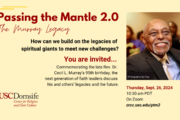This article was originally published in Religion News Service, with the support of CRCC’s global project on engaged spirituality.
YOKOHAMA, Japan (RNS) — In what used to be an elementary school in Kawasaki, just north of this port city on Tokyo Bay, is a specialty care nursing home, a perfect reflection of Japan’s demographic evolution over the past half-century. Almost 20% of the approximately 1.5 million people living in Kawasaki are older than 65. Japan as a whole has seen its birthrate drop to 1.4 children for every woman in 2018 from 2.6 in 1970, even as life expectancy has climbed from 73 years to 85.
Nearly a decade ago, the low number of pupils convinced the local authorities to tear down the school and call for bids to build a nursing home instead. The winner, Social Welfare Corporation Shinko Fukushikai, surprised few who know of its CEO and founder, Masue Katayama. An elegant, 80-year-old “social entrepreneur,” she is not only one of Japan’s few female CEOs but one of the most innovative providers of elderly care in the world.
At the beginning of the 1980s, as Japan’s gray revolution began, Katayama came up with the idea to create nursing homes that would be affordable for the aging middle class while still providing decent services. She bought up abandoned buildings in order to reimagine them as homelike places for people’s last years.
Nowadays, Shinko Fukushikai is running 21 elder care facilities, plus two community centers. The group also runs 10 day care facilities, and it provides support for people with disabilities in six group homes. Her facilities are not only accessible and beautiful, they were the first nursing homes to be certified for compliance with ISO-9001 standards, a stringent regime of quality control.
The Crossheart Saiwai Kawasaki home, opened in 2013 in the former elementary school, summed up her philosophy. Filled with light, air and other human comforts, it is centered on a lobby, designed by Katayama, that has the feel of a modern coffee shop. Armchairs and low tables create a feeling of a living room, with a view of a well-tended garden. The space also accommodates a children’s playground, as the home welcomes people of all ages from the surrounding neighborhood.
While the first floor serves as a meeting point for the elderly who come only for a few hours a day to join in activities with residents, the upper floors are for the people who need more attention and are staying long-term. The staff also visits the elderly in their homes.
“I want to create places where people feel comfortable and where they can naturally be who they are. These are not just places labeled as old people’s homes,” said Katayama.
Katayama stands out for another reason: In a nation nearly equally divided between Buddhism and Shintoism, she takes her inspiration from the Catholic Church. “There was a particular priest who had a lot of influence on me,” she said in an interview. “He taught me that we as human beings are very small and there is a greater power. And it is that power that has been supporting me in what I do.”
Watching how her church serves its larger community, she said, taught her the value of individual devotion to a cause. No matter how small a person’s contribution, everyone together makes big things happen. She encourages her colleagues and employees to put this philosophy to work in their jobs.
“I was always moved by things that were happening in the church. When the Vietnamese refugees arrived in really bad conditions, people gathered in the church to help them,” she said. “That resounded in my heart.”
Honoring that effort, Katayama has long hired caregivers for her nursing homes and other services from as far away as Venezuela and South Sudan, as well as the homeless. “It was the refugees from church and the homeless who helped me build my activities, when I had no money at the beginning,” she said, sitting in a conference room at one of Shinko Fukushikai’s several offices, in the second-tallest building in Japan, the Yokohama Landmark Tower.
She is frustrated by Japan’s strict immigration laws that prevent her from employing more foreign workers, especially given the shortage of native Japanese willing to work with the elderly.
“If we opened up a policy to accept people from other countries, especially from Asia, the labor shortage would be partially solved,” said Seiko Adachi, Katayama’s daughter and director of Shinko Fukushikai.
Adachi said that many of the company’s clients also prefer foreign caregivers because “they are friendly,” theorizing that, in order to overcome the language barrier, foreigners greet the homes’ residents with big smiles and touches.
Katayama, for her part, said, “It is more about learning about other cultures and being open-minded towards them.”
When Katayama introduced her multifunction model, she was disrupting how elder care was done. “In 2013, when the nursing home was opened, there was no place that offered a combination of nursing care, day services at a client’s home and short-stay options in one facility,” said Sakaguchi Ritsue, the home’s director.
Today these practices are common in Japan, and delegations from around Asia and the world visit Shinko Fukushikai properties to study her best practices. “I had absolutely no intention of going against or protesting the regulations,” said Katayama. “It just happened that the services I provided were more in line with what ordinary people — my clients — wanted.”
Click here to read the story on religionnews.com.
Magdalena Rojo is a journalist fellow with the Spiritual Exemplars Project.
Noel Rojo is a journalist fellow with the Spiritual Exemplars Project.









